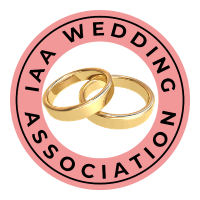
Your offbeat wedding can have way more options for accessibility than a wedding with a focus on making sure everything is done in the traditional way — but having lots of creative options doesn’t mean you have to stress and strive for a new ideal of perfection. Accessible weddings don’t need to be any more stressful than any other wedding. Plan a beautiful, bold, bodacious wedding that’s just right for you. And accessible.
Accessibility isn’t a new idea
While traditional brides might choose to finesse disabilities in their wedding photos, a high percentage of weddings include people who need some accommodation. After all, weddings are one of the few events that include all generations, including elderly family members who may have limited hearing, mobility, or vision.
They’re also a major life event for more people than almost any other. More than half of all American adults get married, and you know that includes plenty of people with disabilities — not to mention all your friends and relatives. Let’s face it, all weddings should be accessible. Statistics alone tell us that most weddings will include someone with a temporary or permanent disability. Planning ahead keeps that fact from creating problems on the day.
So start with our basic information on accessible weddings:
- How to plan a disability-friendly wedding
- 7 questions to ask to make your wedding more accessible
- A field guide to hard of hearing guests
The venue is the biggest deal
Different buildings have different challenges and advantages when it comes to accessibility. This venue has acoustics that will make it harder for hearing-impaired people, that one has no ramps, and the other is a rabbit warren of little rooms that blind guests will have trouble negotiating. Give yourself extra time to find a site that is not only charming but also truly accessible.
Disability friendly wedding venues are so hard to find. Make sure you check for where the bathrooms are – we went to a venue we liked only to discover the bathroom was down a flight of stairs and I couldn’t get to it on my own.
Make sure you visit the venue and see for yourself how accessible it is. You’ll still sometimes find a building where they think “We’ll be happy to help you up the stairs” is a good example of accessibility.
In fact, you might have to be ready to give up some of the charm. You’ll suffer less over this if you recognize the reality ahead of time.
Newer venues may cost a bit more, but often have better disabled access. Community halls that have been recently built could be a lower cost option than a wedding reception venue.
That lovely historic chapel reached by clambering over uneven and rocky paths could be a great place for a slow day of engagement photos, even if it’s not right for your ceremony.
The disabilities are not a big deal
This is not to diminish the effects of disabilities on our lives. It’s to recognize that accommodations are normal in the lives of people who need accommodations. Nobody needs to think of accessible weddings as a problem.
As a MOB who is disabled and will need to use her cane (GASP HORRORS!) to get down the aisle, I was surprised at how many people were obsessed with how I was going to make it down the aisle. I mean, it wasn’t even my wedding! OK, I’ll be a bit slow, and not as graceful as some of the other mothers in recent weddings, but my daughter doesn’t care, she loves me, as I’d support her if she needed assistance getting down the aisle.
If you’re aware of a disability that might affect your wedding, whether it’s your own, a member of the wedding party’s or a guest’s, just make a plan and move on. That well-meaning member of the wedding party who keeps sympathizing about your limited choices of wedding dress with your wheelchair? Tell them you don’t need or want sympathy (and read about wheelchair-friendly wedding dress choices). The vendor who doesn’t get it? Replace them.
We chose a wonderful photographer who was more than happy for my walking stick (or forearm crutch as its also known) to be part of the photos of the day as it is part of me.
Build in some margin
Some weddings are meant to be perfectly choreographed performances with split-second timing. Accessible weddings really aren’t.
We had chairs during the ceremony and a pre-meeting with our celebrant, who knew that fatigue was an issue and knew the signals for when I needed to sit down.
Prioritize the really important elements of the wedding — the things that are most meaningful for you — and cut the things that don’t matter as much. That way you can have a shorter wedding, or you can include breaks. Set aside places where people can collect themselves if that’s important for you or your guests.
One of the things that we (and our guests) found really helpful was having an ‘order of the day’ instead of an order of service, so instead of just listing the readings and the music, our order showed what time the service would start, when it would end, how long a break until the photos, how long a break until the next thing, when there would be food, when there would be snacks – it listed everything. This mean that guests who had to balance resting/medication could plan much more easily. The guests with physical impairments could rest, the guests with social anxiety related issues knew what to expect and when, the guests with autism had a piece of paper they could look at to know what was coming up next.
With clear priorities and determination, accessible weddings can be as chill as any other wedding.
